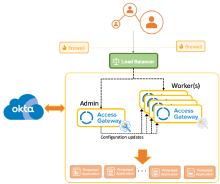High availability
A common scenario after Access Gateway has been deployed, and applications integrated, is to configure High Availability.
Access Gateway High Availability is a single admin node that maintains and propagates configuration changes to worker nodes. You can also use it as a regular admin node, and route requests from your load balancer to it.
You provision an admin node and designate it as High Availability. Next, you provision worker nodes and attach them to the High Availability admin node. These worker nodes obtain all configurations from this admin node, and you don't configure apps on them.
You can only access worker nodes that are part of a High Availability cluster using the Access Gateway Management console. The Access Gateway Admin UI console is only available on admin nodes and nodes that haven't been configured as worker nodes.
This architecture diagram shows the admin node passing configuration updates to the worker nodes.
The admin node also receives requests from the load balancer, like the worker nodes. You can remove it from the load balancer configuration if you don't want it to receive requests.

